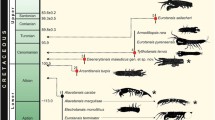Abstract
The juveniles of Caprella monoceros after emerging from the brood pouch cling to their mother's body for 16.0 days. The juveniles molt and grow at least four times while on their mother. The mother often grooms her juveniles with 1st gnathopods, and defends the juveniles from other caprellids. Even after moving from the mother's body to a seaweed substratum the juveniles stay near their mother for more than 10 days, and are often picked up and carried by their mother when she moves away. On the other hand, the juveniles of Caprella decipiens after emerging from the brood pouch do not cling to their mother, but immediately move to the seaweed substratum around the mother and stay there to molt and grow for 32.5 days. The juveniles are defended by their mother. Only at the time when their mother moves away, juveniles cling to the mother and are carried to other places. During the maternal care period, moltings of mothers seem to be suppressed in C. monoceros, while mothers of C. decipiens continue to molt. The females of C. monoceros mature at a smaller size and produce fewer eggs than C. decipiens.
Similar content being viewed by others
References
Aoki, M. & T. Kikuchi, 1990a. Habitat adaptations of caprellid amphipods and the importance of epiphytic secondary habitats in a Sargassum patens bed in Amakusa, southern Japan. Publ. Amakusa Mar. Biol. Lab. 10: 123–133.
Aoki, M. & T. Kikuchi, 1990b. Caprella bidentata Utinomi, 1947 (Amphipoda: Caprellidea), a synonym of Caprella monoceros Mayer, 1890 supported by experimental evidence. J. Crust. Biol., 10: 537–543.
Borowsky, B., 1980. Factors that affect juvenile emergence in Gammarus palustris (Bousfield, 1969). J. exp. mar. Biol. Ecol. 42: 213–223.
Croker, R. A., 1968. Return of juveniles to the marsupium in the amphipod Neohaustorius schmitzi Bousfield. Crustaceana 14: 215.
Caine, E. A., 1977. Feeding mechanisms and possible resource partitioning of the Caprellidae (Crustacea: Amphipoda) from Puget Sound, USA. Mar. Biol. 42: 331–336.
Caine, E. A., 1979a. Functions of swimming setae within caprellid amphipods (Crustacea). Biol. Bull. 156: 169–178.
Caine, E. A., 1979b. Population structures of two species of caprellid amphipods (Crustacea). J. exp. mar. Biol. Ecol. 40: 103–114.
Dahl, E., H. Emanuelson & C. von Mecklenburg, 1970. Pheromone transport and reception in an amphipod. Science 170: 739–740.
Harrison, R. J., 1940. On the biology of the Caprellidae. Growth and moulting of Pseudoprotella phasma Montagu. J. mar. biol. Ass. U.K. 24: 483–493.
Hazlett, B. A., 1983. Parental behavior in decapod Crustacea. In S. Rebach & D. W. Dunham (eds.), Studies in adaptation, the behavior in higher Crustacea. John Wiley & Sons, New York: 171–193.
Imada, K., A. Hirayama, S. Nojima & T. Kikuchi, 1981. The microdistribution of phytal amphipods on Sargassum seaweeds. Res. Crust. 11: 124–137.
Laubitz, D. R., 1976. On the taxonomic status of the family Caprogammaridae Kudrjaschov & Vassilenko (Amphipoda). Crustaceana. 31: 145–150.
Lewbel, G. S., 1978. Sexual dimorphism and intraspecific aggression, and their relationship to sex ratio in Caprella gorgonia Laubitz & Lewbel (Crustacea: Amphipoda: Caprellidae). J. exp. mar. Biol. Ecol. 33: 133–151.
Lim, S. T. A. & C. G. Alexander, 1986. Reproductive behavior of the caprellid amphipod, Caprella scaura typica Mayer, 1890. Mar. Behav. Physiol. 12: 217–230.
Little, E. E., 1975. Chemical communication in maternal behavior of crayfish. Nature 255: 400–401.
Little, E. E., 1976. Ontogeny of maternal behavior and brood pheromone in crayfish. J. Comp. Physiol. 112: 133–142.
Mattson, S. & T. Cedhagen, 1989. Aspects of the behavior and ecology of Dyopedos monacanthus (Metzger) and D. porrectus Bate, with comparative notes on Dulichia tuberculata Boeck (Crustacea: Amphipoda: Podoceridae). J. exp. mar. Biol. Ecol. 127: 253–272.
McCain, C., 1970. Familial taxa within the Caprellidea (Crustacea: Amphipoda). Proc. biol. Soc. Wash. 82: 837–842.
McCloskey, L. R., 1970. A new species of Dulichia (Amphipoda, Podoceridae) commensal with a sea urchin. Pac. Sci. 24: 90–98.
Sheader, M. & Chia, F.-S., 1970. Development, fecundity and brooding behavior of the amphipod, Marinogammarus obtusatus. J. mar. biol. Ass. U.K. 50: 1079–1099.
Author information
Authors and Affiliations
Additional information
Contributions from the Amakusa Marine Biological Laboratory, Kyushu University, No. 354.
Contributions from the Amakusa Marine Biological Laboratory, Kyushu University, No. 354.
Rights and permissions
About this article
Cite this article
Aoki, M., Kikuchi, T. Two types of maternal care for juveniles observed in Caprella monoceros Mayer, 1890 and Caprella decipiens Mayer, 1890 (Amphipoda: Caprellidae). Hydrobiologia 223, 229–237 (1991). https://doi.org/10.1007/BF00047642
Issue Date:
DOI: https://doi.org/10.1007/BF00047642




